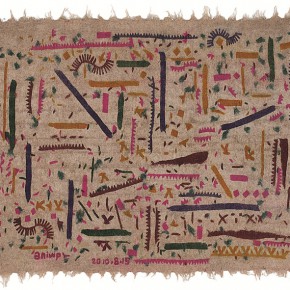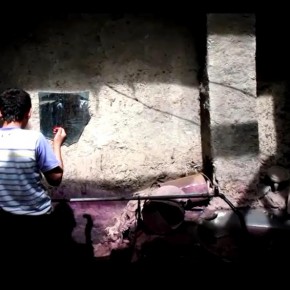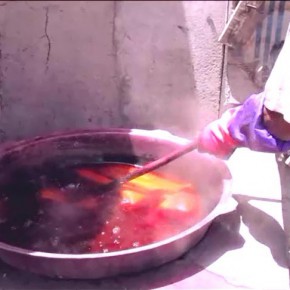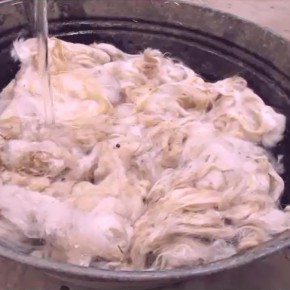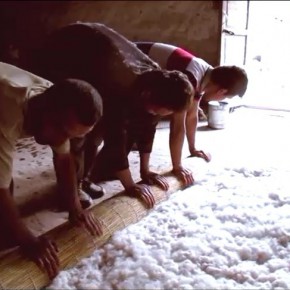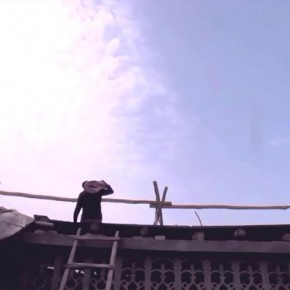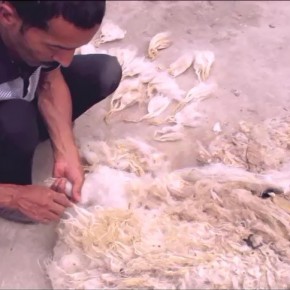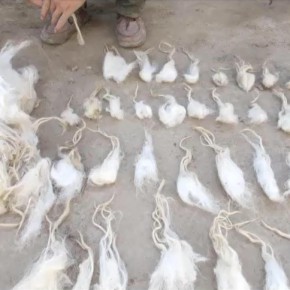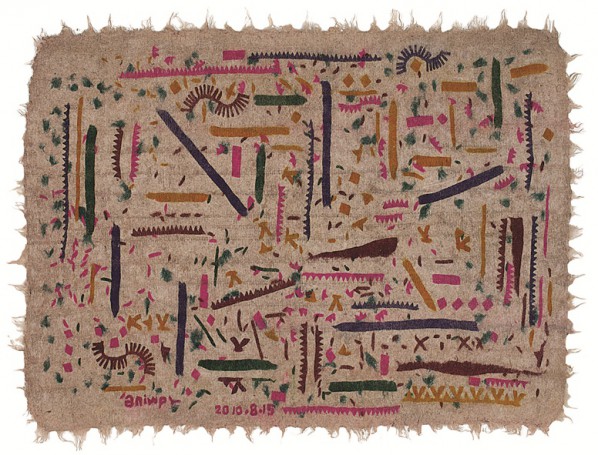
Pékin Fine Arts is pleased to host “Sun, Water and Wind”, the gallery’s 1st solo exhibit of artist Aniwar Mamat. Aniwar’s oil on canvas and mixed media paintings were most recently seen in the 1st Xinjiang International Art Biennale (2014) in Urumqi; and, at Pékin Fine Arts Beijing gallery’s group exhibition “Why Paint?” (April – June 2013). His wool felt tapestry works were included in the international group exhibit “Decorum: Carpets and Tapestries By Artists” (Apr 26 – Jul 13, 2014) jointly organized by the Musée d’Art Moderne de la Ville de Paris and the Shanghai Power Station of Art. The current exhibit, “Sun, Water and Wind”, presents the artist’s most recent exploration of traditional Uyghur (Xinjiang) tapestry making techniques adapted to his designs.
Aniwar’s reinterpretations of Uyghur wool felt tapestries, just completed in cooperation with local Xinjiang craftsman, will premiere at Pékin Fine Arts, together with Aniwar’s short documentary film. The film records a painstaking rolled-felt production process in a remote Uyghur village, as the artist introduces his fastidious taste for minimalist abstraction to local craftsmen, by arranging strips of color bands, one-by-one, across the soaked, pressed and rolled sheep’s wool felt. The film captures - without directly addressing - the stark divide between Xinjiang city-dwellers and rural villagers. What is also plainly evident is the uncertain future of traditional handcrafts and skilled craftsmen, (here, paying tribute to the unique skills of Uyghur wool felt rolling and color - dying artisans), against market demand for mass-produced, machine-made goods.
Aniwar, a Uyghur-rooted, Beijing-based abstractionist of long-standing (since the late 1990’s), has built a career on quietly challenging prevailing social-realist norms. His fidelity to abstraction, long pre-dating the art world’s fashionable embrace of the neo-pop, op art abstraction of today, remains at the core of his determined artistic strategy. In recent years, the artist has experimented with adapting traditional Uyghur felt making to his vision of contemporary abstraction. Whether on felt or on canvas, the artist’s abstract works are consistently minimalist, comprised of bright contrasting color bands, rejecting more popular narrative, folkloric motifs, while retaining the vivid Central Asian colors used in traditional Xinjiang carpet and textile design. Aniwar’s colors – taken from his Uyghur heritage – embrace the brighter hues first imported to China by Uyghur carpet makers over 1000 years ago via the Silk Road, and differ radically from colors preferred by the Han of Eastern China. Even today, the more vivid Central Asian color palette remains far removed from Beijing’s preferred greys, and Imperial reds and yellows.
Today, the artist’s painterly choices are extended to his felt tapestries: Aniwar’s compositions are decidedly the product of his minimalist aesthetic, while his fidelity to a Uyghur color palette remains traditional. The colors chosen are never arbitrary and instead reflect a fidelity to his heritage. His felt tapestry making color choices may also stem from local limitations, reflecting limited access to dyes in these remote and economically challenged Xinjiang villages. The foreground or main body of each felt tapestry for instance is either off white or dark brown, remaining un-dyed, and true to the original lamb’s wool colors. Only the bands of color are dyed. On a practical level, the mash-up of contemporary design and traditional Uyghur colors makes the work a bit more familiar to local craftsman, does not radically inflate production costs, and is likely providing a simpler means of gaining their initial cooperation. Despite the modern film shoot, the world of the craftsman seems almost medieval, relying on skills and basic tools little changed over the centuries.
The artist’s experiments conducted in this remote Xinjiang village, marrying contemporary abstraction and age-old wool felt craftsmanship, is admirably idiosyncratic and typical of Aniwar’s singular vision. Aniwar consistently challenges so-called prevailing wisdom, deftly sidestepping artificial boundaries created by market demands. Unmoved by popular trends, Aniwar’s is a personal quest, a never-ending lifetime pursuit exploring the language of abstraction and cultural heritage. His unwavering determination to go his own way is Aniwar’s greatest strength – and may one day be among his greatest contributions to the Chinese contemporary art scene.
About the exhibition
Duration: 7th March – 9th May 2015
Venue: Pékin Fine Arts, Beijing
Courtesy of the artist and Pékin Fine Arts, for further information please visit www.pekinfinearts.com.
For more information, please contact info@pekinfinearts.com or tel: (8610) 5127 3220 or (852) 2177 6190.
For more information, please contact info@pekinfinearts.com or (8610) 5127 3220. Thanks!


